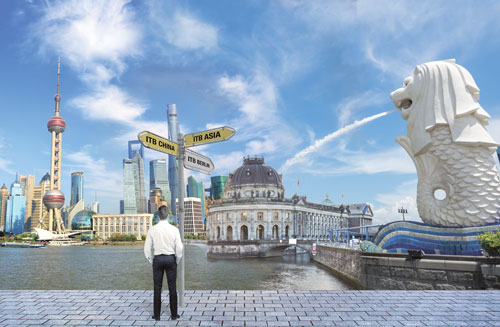First it launched an Asia edition and now, a China edition of ITB. While Messe Berlin believes there is no confusion, the reality is tradeshow-fatigued exhibitors will have to think carefully where they should put their money.
First it launched an Asia edition and now, a China edition of ITB. While Messe Berlin believes there is no confusion, the reality is tradeshow-fatigued exhibitors will have to think carefully where they should put their money.
 With huge markets such as China, India and South-east Asia, the region is without doubt the current and future source, not just for Asia itself but the world. It’s the reason for Messe Berlin’s expansion into Asia, launching a new edition of ITB in China next month, eight years after inaugurating ITB Asia in Singapore.
With huge markets such as China, India and South-east Asia, the region is without doubt the current and future source, not just for Asia itself but the world. It’s the reason for Messe Berlin’s expansion into Asia, launching a new edition of ITB in China next month, eight years after inaugurating ITB Asia in Singapore.
So how does ITB China differ to the slew of tradeshows in China that includes China International Travel Mart (CITM) and Shanghai World Travel Fair (SWTF), and indeed, to its sister ITB Asia?
According to ITB China general manager David Axiotis, ITB Asia reaches out to all Asian source markets, including India, while ITB China has predominantly Chinese buyers. The first show will host 600 selected Chinese buyers from all over the country representing more than 180 Chinese companies including Ctrip, Tuniu, Caissa and Utour. Along with the 600 Chinese buyers, ITB China is also hosting 100 international buyers.
Nearly half of the buyers (49 per cent) are buying leisure, 24 per cent MICE, 21 per cent corporate and six per cent technology, he said. Forty-four per cent are final decision makers, while 29 per cent are involved in decision making and 27 per cent are in advisory capacity.
As to how ITB China differs from existing tradeshows in China, Axioms said ITB China is purely B2B whereas a show like SWTF is “rather a mix of B2B and B2C”.
He added: “ITB China will also have more focus on IT than the other shows, including various technology companies offering their products. Many shows have debuted in China in recent years and they all have their own character. CITM is a platform for image building, but I believe ITB China will showcase more information for overseas travel.”
Apart from “powerful” keynote sessions on Day 1 (May 10) which will include an interview with Ctrip’s CEO Jane Sun, there will be an Online Travel and Travel Technology Day on May 11 along with a newly-created eTravel World China, an exhibition area dedicated to online travel and travel technology solutions with exhibitors comprising the likes of Amadeus, Expedia and Booking.com.
Organisers of existing tradeshows in China did not respond at press time to TTG Asia’s queries regarding the new competition ITB China may pose to their events.
Tradeshow fatigue
An exhibitor, BCD Travel’s Greater China managing director Jonathan Kao, said “of course there will be tradeshow fatigue, given the many travel-related shows in China”.
He pointed out events already face some competition from social media channels. Citing WeChat as an example, Kao said its group chat function acts as a platform for information exchange and word-of-mouth referrals.
“Frankly, there are maximum 500 contacts within the group chat, while you may not be able to remember all your handshakes made at a tradeshow. Therefore, it’s vital for new shows to bring in new and different ideas in order to survive.”
Messe Berlin’s senior vice president travel and logistics, Dr Martin Buck, said: “We know that we are entering a very competitive marketplace with well-established tradeshows that have been around for a while. We are very conscious not only to offer a lot but also to deliver, if we want to be successful.”
With Chinese outbound hitting a mind-spinning 122 million travellers last year, exhibitors have made a beeline for the show, especially those from Europe which badly need Chinese tourism dollars for various reasons. France, for instance, has seen its China market share dwindling as a result of terror attacks. Switzerland has been wooing Chinese and Asian travellers as traditional markets stagnate or stay away due to the high Swiss franc and the top prices the destination charges because of quality and higher cost of living.
ITB China’s 12,000m2 show floor thus is sold out, with about 40 per cent of exhibitors making their way to Shanghai from Europe, 36 per cent from Asia (including Chinese sellers Tencent, Jin Jiang Hotel Group, CN Travel Group, etc), 14 per cent from the Middle East and 10 per cent from the Americas.
“The exhibition covers everything the industry has to offer – MICE, NTOs, business travel, tour operators, tourism associations and societies,” said Axiotis.
Buyers from OTAs like Ctrip and Tuniu said ITB China could help spur development and business. Ctrip aims to be a global OTA in future, while Tuniu wants to create “a big data platform” that can generate valuable intelligence for business.
Tuniu’s general manager of overseas sourcing centre, Frank Wu, said: “We now feature 1.5 million boutique itineraries that cover 150 countries and areas. In the long run, we hope to develop not just an online booking system but create a big data platform with clients’ preferences, travel patterns and habits collected. Ultimately, based on the data, we may generate valuable information for business.”
Whether or not ITB China will be the premier China and Asia tradeshow remains to be seen. For now, it’s show time for Messe Berlin as it lays out the red carpet to welcome buyers and sellers to its latest travel trade exhibition.
This article was first published in TTG Asia April 2017 issue. To read more, please view our digital edition or click here to subscribe.




















